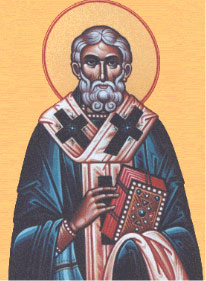
Cyril was born in Jerusalem around 315, and became bishop of that city in about 349. The years between the Council of Nicea (325) and the Council of Constantinople (381) were troubled years, in which the Church, having committed itself at Nicea, over the strenuous protests of the Arians, to the proposition that the Son is "one in being" (homo-ousios) with the Father, began to backtrack and consider whether there was some other formula that would adequately express the Lordship of Christ but not be "divisive." Experience with other ways of stating what Christians believed about the Son and his relation to the Father finally led the Church to conclude that the Nicene formulation was the only way of safeguarding the doctrine that Thomas spoke truly (John 20:28) when he said to Jesus, "My Lord and My God!" But this was not obvious from the beginning, and Cyril was among those who looked for a way of expressing the doctrine that would be acceptable to all parties. As a result, he was exiled from his bishopric three times, for a total of sixteen years, once by the Athanasians and twice by the Arians. He eventually came to the conclusion, as did most other Christians of the time, that there was no alternative to the Nicene formula, and in 381 he attended the Council of Constantinople and voted for that position.
Cyril is author of the Catecheses, or Catechetical Lectures on the Christian Faith. These consist of an introductory lecture, then eighteen lectures on the Christian Faith to be delivered during Lent to those about to be baptized at Easter, and then five lectures on the Sacraments to be delivered after Easter to the newly baptized. These have been translated into English (F L Cross, 1951), and are the oldest such lectures surviving. (It is thought that they were used over and over by Cyril and his successors, and that they may have undergone some revision in the process.)
Every year, thousands of Christian pilgrims came to Jerusalem, especially for Holy Week. It is probably Cyril who instituted the liturgical forms for that week as they were observed in Jerusalem at the pilgrimage sites, were spread to other churches by returning pilgrims, and have come down to us today, with the procession with palms on Palm Sunday, and the services for the following days, culminating in the celebration of the Resurrection on Easter Sunday. We have a detailed account of Holy Week observances in Jerusalem in the fourth century, thanks to a a Spanish nun named Egeria who made a pilgrimage to Jerusalem and kept a journal which is a historian's delight.
Note: In reading the collect some Christians will wish to substitute the word "pastors" for the word "bishops."
written by James Kiefer